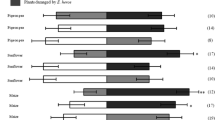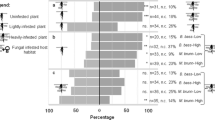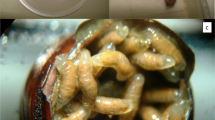Abstract
Although there are many examples of the role of volatile infochemicals in interactions between trophic levels of insect communities, surprisingly little is known of volatile interactions between species within the third trophic level. Recently it was found that Leptopilina heterotoma, an endoparasitoid that attacks Drosophila larvae, avoids one type of patches (decaying stinkhorn mushrooms) when parasitoids of another species (L. clavipes) are present on these patches. L. heterotoma is able to smell the presence of L. clavipes from a distance (Fig. 1). In this paper we investigate the source of the odour that induces avoidance behaviour, by varying the host species and parasitoid species present on stinkhorn mushrooms, and by using another type of patch (sap-fluxes of wounded trees). L. heterotoma was found to avoid stinkhorn patches with conspecific as well as heterospecific parasitoids (Fig. 2). Hosts had to be present in the patch to elicit avoidance, but avoidance behaviour was also found with another host species present in the patch (Fig. 3). No avoidance behaviour was found with sap-flux patches with hosts and parasitoids on them (Fig. 4). Avoidance of stinkhorn patches only occurred when the parasitoids present on the patch were able to contact hosts (Figs. 5 and 6). The exact source of the odour that elicits avoidance is still unclear, so that one can only speculate on the function of the signal. However, there is a clear benefit to the receiver, because it is able to avoid superior competitors. Avoidance can lead to non-aggregated parasitoid distributions. The importance of avoidance behaviour for population dynamics and stability of parasitoid-host systems is discussed.
Similar content being viewed by others
References
Baalen M van, Sabelis MW (1993) Coevolution of patch selection strategies of predator and prey and the consequences for ecological stability. Am Nat 142:646–670
Byers JA (1993) Avoidance of competition by bark beetle species, Ips tvpographus and Pityogenes chalcographus. Experientia 49:272–275
Dicke M (1994) Local and systemic production of volatile herbivore-induced terpenoids: their role in plant-carnivore mutualism. J Plant Physiol 143:465–472
Dicke M, Sabelis MW (1988) Infochemical terminology: based on cost-benefit analysis rather that origin of compounds? Funct Ecol 2:131–139
Dicke M, Bruin J, Sabelis MW (1993) Herbivore-induced plant volatiles mediate plant-carnivore, plant-herbivore and plant-plant inteactions: talking plants revisited. In: Schultz J, Raskin I (eds) Plant Signals in interactions with other organisms. Am Soc Plant Physiol, Rockville, Md, pp 182–196
Driessen G, Hemerik L, Alphen JJM van (1990) Drosophila species breeding in the stinkhorn (Phallus impudicus Pers.) and their larval parasitoids. Neth J Zool 40:409–427
Driessen G, Hemerik L, Boonstra B (1991) Host selection behaviour of the parasitoid Leptopilina clavipes, in relation to survival in hosts. Neth J Zool 41:99–111
Hassell MP, May RM (1973) Stability in insect host-parasite models. J Anim Ecol 42:693–726
Hassell MP, May RM (1974) Aggregation of predators and insect parasites and its effect on stability. J Anim Ecol 43:567–594
Hassell MP, May RM (1988) Spatial heterogeneity and the dynamics of parasitoid-bost systems. Ann Zool. Fenn 25:55–61
Hassell MP, May RM, Pacala SW, Chesson PL (1991) The persistence of host parasitoid associations in patchy environments. I. A general criterion. Am Nat 138:568–583
Höller C, Micha SG, Schulz S, Francke W, Pickett JA (1994) Enemy-induced dispersal in a parasitic wasp. Experientia 50:182–185
Janssen A (1989) Optimal host selection by Drosophila parasitoids in the field. Funct Ecol 3:469–479
Janssen A, Driessen G, Haan M de, Roodbol N (1988) The impact of parasitoids on natural populations of temperate woodland Drosophila. Neth J Zool 38:61–73
Janssen A, Alphen JJM van, Sabelis MW, Bakker K (1991) Microhabitat selection behaviour of Leptopilina heterotoma changes when odour of competitor is present. Redia 74:203–210
Janssen A, Alphen JJM van, Sabelis MW, Bakker K (in press) Odour-mediated avoidance of competition in Drosophila parasitoids: The ghost of competition Oikos
Murdoch WW, Steward-Oaten A (1989) Aggregation by parasitoids and predators: effects on equilibrium and stability. Am Nat 134:288–310
Murdoch WW, Briggs CJ, Nisbet RM, Gurney WSC, Steward-Oaten A (1992) Aggregation and stability in metapopulation models. Am Nat 140:41–58
Nagelkerke CJ, Baalen M van, Sabelis MW (in press) When to avoid adding eggs to the clutch of another female? A simultaneous oviposition-and-sex-allocation game. Evol Ecol
Pacala SW, Hassell MP (1991) The persistence of host-parasitoid associations in patchy environments. II. Evaluation of field data. Am Nat 138:584–605
Price PW (1970) Trail odors: recognition by insects parasitic on cocoons. Science 170:546–547
Price PW (1981) Semiochemicals in evolutionary time. In: Nordlund DA, Jones RL, Lewis WJ (eds) Semiochemicals-their role in pest control. Wiley, New York, pp 251–279
Price PW, Bouton CE, Gross P, McPheron BA, Thompson JN, Weis AE (1980) Interactions among three trophic levels: Influence of plants on interactions between insect herbivores and natural enemies. Annu Rev Ecol Syst 11:41–65
Tumlinson JH, Turlings TCJ, Lewis WJ (1993) Semiochemically mediated foraging behavior in beneficial parasitic insects. Arch Insect Biochem Physiol 22:385–391
Vet LEM, Lenteren JC van, Heymans M, Meelis E (1982) An airflow olfactometer for measuring olfactory responses of hymenopteran parasitoids and other small insects. Physiol Entomol 8:97–106
Wiskerke JSC, Dicke M, Vet LEM (1992) Larval parasitoid uses aggregation pheromone of adult hosts in foraging behaviour: a solution to the reliability-detectability problem. Oecologia 93:145–148
Wood DL (1982) The role of pheromones, kairomones, and allomones in the host selection and colonization behavior of bark beetles. Annu Rev Entomol 27:411–446
Author information
Authors and Affiliations
Additional information
Communicated by M. A. Elgar
Rights and permissions
About this article
Cite this article
Janssen, A., van Alphen, J.J.M., Sabelis, M.W. et al. Specificity of odour-mediated avoidance of competition in Drosophila parasitoids. Behav Ecol Sociobiol 36, 229–235 (1995). https://doi.org/10.1007/BF00165831
Received:
Accepted:
Issue Date:
DOI: https://doi.org/10.1007/BF00165831




